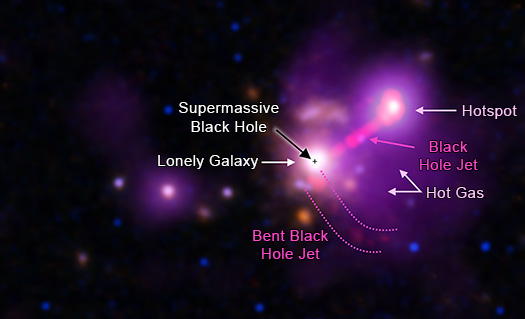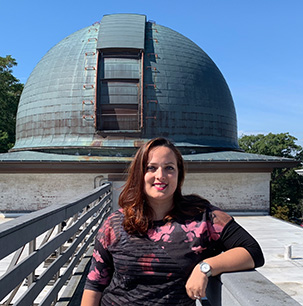Powerful Yet Lonely: The Distant Quasar Left Alone in its Group
We are happy to welcome Valentina Missaglia as a guest blogger. She is the first author of the paper that is the subject of our latest press release. She is currently a postdoctoral researcher at the Institute of Astrophysics — FORTH in Heraklion (Crete) in the SMILE (“Search for Milli-LEnses”) group, recently funded by an ERC grant, that aims at investigating the nature of dark matter through observations of gravitational lenses on milli-arcsecond scales. Valentina earned her Ph.D. from the University of Turin (Italy) and her research focuses on radio and X-ray emission from radio-loud active galactic nuclei (which contain supermassive black holes that are rapidly pulling in material, producing intense radio waves) and how these sources interact with the surrounding medium. Before starting her Ph.D. in 2019, Valentina was a visiting student at the Center of Astrophysics | Harvard & Smithsonian, where she collaborated with Dr. Ralph Kraft on observations of galaxy clusters performed with NASA’s Chandra X-ray Observatory.
Looking at the night sky with the naked eye, we can only see an infinitesimal part of what the Universe contains, and the largest part cannot even be “seen”. Radio wavelengths have gifted us some of the most fascinating astronomical sources: radio-loud active galactic nuclei in the centers of galaxies, which can produce jets that extend way farther out from the optical galaxy itself.
The most powerful radio sources in the northern hemisphere are listed in a well- studied catalog, the Third Cambridge Catalog (3C), which contains the source we investigated with multiwavelength observations: 3C 297. This source appeared very intriguing in observations performed with Chandra in 2016. Therefore, we requested more time to better investigate features that we uncovered thanks to this first short observation, such as hot, X-ray emitting gas around our source.
This source is very far from us and, therefore, very far in the past. Optical, radio and X-ray observations were crucial to draw the full picture of such a powerful, and old, astronomical source. At the beginning of this journey, we wanted to investigate if this source was hosted in a galaxy cluster, that is, the ensemble of 100 galaxies or more. At that time in the universe’s evolution, galaxy clusters are still forming and X-ray observations can be used not only to identify a galaxy cluster through the glow of the hot gas they contain, but also to verify if mergers with other clusters are occurring or not.

3C 297, Labeled Credit: X-ray: NASA/CXC/Univ. of Torino/V. Missaglia et al.; Optical: NASA/ESA/STScI & International Gemini Observatory/NOIRLab/NSF/AURA; Infrared: NASA/ESA/STScI
Moreover, powerful radio sources tell us where to look for galaxy clusters at large distances from Earth. But there comes the contradiction: the detection of hot gas with Chandra pointed toward the presence of a galaxy cluster, i.e. we expected that about a 100 or more galaxies should be around 3C 297. Optical data revealed, instead, no galaxies.
We therefore think that we have observed a so-called “fossil group”, that is, a system with an amount of X-rays that is typical for a galaxy group. Galaxy groups are ensembles of tens of galaxies (not hundreds as it is for galaxy clusters), that are called “fossil” when we observe only a single isolated giant elliptical galaxy without companions. The companions have, indeed, merged to form one entity in the early universe. This is the first time a fossil group has been observed at such a high distance from us!
Apart from all the exciting science we performed, this work is also a wonderful international collaboration, and shows the value of perseverance and hard work. In fact, we had just completed our preparation for optical observations with the Gemini telescope to test whether the giant elliptical galaxy had companions when the pandemic hit and the telescopes closed. The first program lapsed without science data, and the second proposal submission was unsuccessful. We then applied (a third time) to the fast turnaround program at Gemini North and finally obtained science data! In the meantime, Chandra observations were delivered in over two years.
To better investigate the extended emission detected in the X-ray we are also going to request low-frequency radio data, so … stay tuned!

